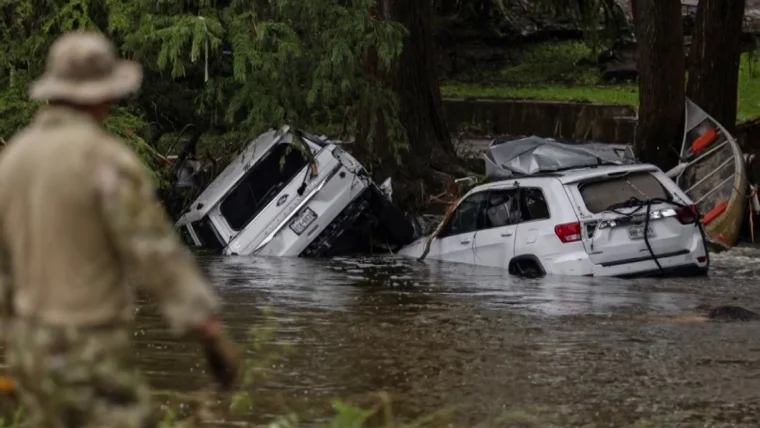Four ‘1-in-1,000-Year’ Storms Hit North Carolina and Illinois in One Week
NORTH CAROLINA — In a staggering display of extreme weather, the United States experienced four separate “1-in-1,000-year” storms in less than a week, including devastating floods across North Carolina, Illinois, Texas, and New Mexico, according to a report from NBC News.
The term “1-in-1,000-year” describes the statistical rarity of these storms — each having a mere 0.1% chance of occurring in any given year. But for these to strike four states within a single week has stunned climate scientists, who warn that such events will become more frequent due to rising global temperatures.
Storms Leave Devastation Across Multiple States
The string of disasters began with catastrophic flooding in central Texas, where over 120 people were killed in Hill Country after the Guadalupe River surged 20 feet in 90 minutes, washing away infrastructure.
Days later, Tropical Storm Chantal dumped 12 inches of rain in 24 hours across central North Carolina, prompting multiple rescues and placing the state under continued flood watches. The total number of deaths remains under review.
In Chicago, nearly 5 inches of rain fell in 90 minutes, overwhelming drainage systems and prompting emergency evacuations in Garfield Park.
And in Ruidoso, New Mexico, three people died in flash floods made worse by terrain scarred from past wildfires — a factor that worsens runoff.
Experts Blame Climate Change
According to Kristina Dahl, Vice President of Science at Climate Central, “to see events that are historic and record-breaking in multiple parts of the country over the course of one week is even more alarming.”
Russ Schumacher, director of the Colorado Climate Center, added that these events, while statistically rare, are increasingly likely on a national scale due to climate change:
“A warmer atmosphere holds more moisture. That means storms can unleash far more rain in a short amount of time.”
Local Impact and National Debate
The storms reignited policy debates across states. In North Carolina, state leaders had recently been touting economic success and business-friendly policies — prompting political tension when climate disasters hit.
Rep. Brenden Jones tweeted that Republican policies of “low taxes and fewer regulations” were driving North Carolina’s growth, citing a new report from CNBC naming the state America’s Top State for Business in 2025.
But critics quickly pointed out flaws. Political commentator @electionsjoe fired back:
“For the past 151 years, Democrats have controlled the governorship of North Carolina for 131 of those. What are you talking about?”
Storms Add Pressure to Preparedness Gaps
Experts like Dave Gochis, a hydrometeorologist at Airborne Snow Observatories, emphasized the need for terrain-sensitive flood planning. In Texas, thin soil and rocky landscapes worsened runoff. In Illinois and New Mexico, previous environmental damage created flash flood risks.
The takeaway? Extreme weather isn’t just a national trend — it’s a local emergency.
Climate Events Are a Wake-Up Call
“The news cycle moves fast,” said Dahl. “But for the people living through these floods, recovery is a years-long process.”
The recent events serve as a clear warning: policymakers must prioritize climate resilience, flood prevention infrastructure, and emergency preparedness — or face repeat devastation in more communities, more often.
Have you or someone you know been affected by the recent flooding in North Carolina or Illinois? Share your story in the comments on SaludaStandard-Sentinel.com — we want to hear how these storms are impacting your community.







